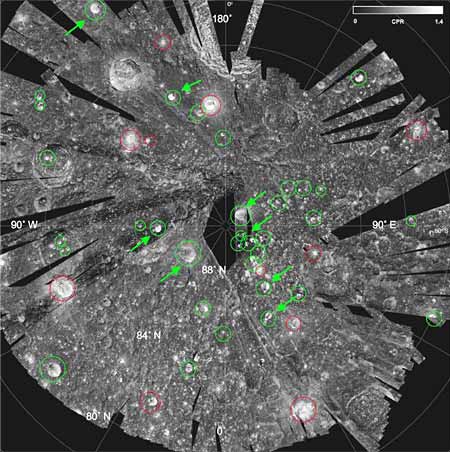Tons of Water Ice Found on the Moon's North Pole

Thisstory was updated at 6:39 p.m. ET.
Vastpockets of water ice numbering in the millions of tons have been discovered atthe north pole of the moon, opening up another region of the lunar surface forpotential exploration by astronauts and unmanned probes, NASA announced Monday.
ANASA radar instrument on an Indian moon probe found evidence of at least 600million metric tons of water ice spread out on the bottom of craters at thelunar north pole. It is yet another supply of lunar water ice, a vital resourcethat could be mined to produce oxygen or rocket fuel to support a futuremoon base, NASA officials said.
Morethan 40 craters ranging from 1 mile (2 km) to 9 miles (15 km) wide were foundharboring the water ice, which was detected using NASA?s Mini-SAR radarinstrument on India?s Chandrayaan-1 lunar orbiter. The instrument is also knownas Mini-RF in NASA parlance.
"Afteranalyzing the data, our science team determined a strong indication of waterice, a finding which will give future missions a new target to further exploreand exploit," said Jason Crusan, program executive for the Mini-RF Programfor NASA's space operations program in Washington, D.C., in a statement.
Water,water everywhere
Theice was discovered in permanently shadowed craters at the moon?s north pole.Similar conditions of perpetual night exist at the moon?s south pole as well,where water ice was also confirmed to be present last year. Because theseregions never see sunlight, water can stay in its frozen form indefinitely.
Get the Space.com Newsletter
Breaking space news, the latest updates on rocket launches, skywatching events and more!
LastSeptember, NASA and other scientists confirmed without a doubt the existence ofwater ice at the moon?s south pole, as well as signals of water moleculesacross large areas of the lunar surface. Several spacecraft, including India?sChandrayaan-1 probe that carried the radar instrument used for the newfindings, found hard evidence of wateron the moon.
InOctober, NASA crashed two impactor probes into the lunar south pole in anattempt to kick up clouds of water ice and measure it from an orbitingspacecraft and other space and ground-based observatories. The subsequentanalysis turned up significantamounts of water and water vapor in the debris cloud, NASA scientists said.
"Theemerging picture from the multiple measurements and resulting data of theinstruments on lunar missions indicates that water creation, migration,deposition and retention are occurring on the moon," said Paul Spudis,principal investigator of the Mini-SAR experiment at the Lunar and PlanetaryInstitute in Houston, in a statement. "The new discoveries show the moonis an even more interesting and attractive scientific, exploration andoperational destination than people had previously thought."
The research will be detailed in the journal Geophysical Research Letters.
Willastronauts go?
Waterice is a tantalizing find anywhere on the moon because it can serve as a naturalresource for astronauts on future lunar landing missions. The ice could bemelted into drinking water or be separated into its component oxygen andhydrogen to provide breathing air and rocket fuel, NASA officials have said inthe past.
NASAhad planned to send astronauts on new lunar landing missions by 2020 as part ofits Constellation program. The program was building the new Altair moonlanders, as well as the Orion spacecraft and Ares rockets needed to launch ferrythem to lunar surface, but experts said it was extremely underfunded and behind schedule.
Lastmonth, President Barack Obama ordered NASA to cancel the Constellation programand focus on using commercial spacecraft to launch American astronauts to orbitinstead. The move is aimed at freeing up NASA to concentrate on more loftyexploration missions, such as returning to the moon or sending astronauts tovisit an asteroid, stable regions in space called Lagrange points or the moonsof Mars.
NASAchief Charles Bolden told members of the U.S. Senate and Congress last weekthat Mars is expected to be the ultimate destination for astronauts. But themoon, he said, is still a good interim target to serve as a steppingstone for more distant space exploration goals.
Chandrayaan-1?sMini-SAR radar was one of two instruments involving NASA on India?sChandrayan-1 spacecraft. The probe also carried the Moon Mineralogy Mapper forNASA. A version of Mini-SAR, called Mini-RF, is riding on NASA?s LunarReconnaissance Orbiter.
Indialaunched Chandrayaan-1 probe in October 2008 and carried 11 instruments toobserve the moon from lunar orbit. It was India?s first moon probe and carriedan impactor probe that it unleashed in November 2008. The spacecraft wentoffline in late August 2009 after an abrupt malfunction cut off communicationswith Earth.
Indiais planning a successor to Chandrayaan-1, dubbed Chandrayaan-2. The nameChandrayaan means ?moon craft? in Sanskrit.
Thenew Chandrayaan-2 mission is slated to launch in 2013, according to Indian newsreports.
- Images- Future Moon Bases
- WhatThis Means for Lunar Colonization
- TheGreatest Lunar Crashes Ever
Join our Space Forums to keep talking space on the latest missions, night sky and more! And if you have a news tip, correction or comment, let us know at: community@space.com.

Tariq is the Editor-in-Chief of Space.com and joined the team in 2001, first as an intern and staff writer, and later as an editor. He covers human spaceflight, exploration and space science, as well as skywatching and entertainment. He became Space.com's Managing Editor in 2009 and Editor-in-Chief in 2019. Before joining Space.com, Tariq was a staff reporter for The Los Angeles Times covering education and city beats in La Habra, Fullerton and Huntington Beach. In October 2022, Tariq received the Harry Kolcum Award for excellence in space reporting from the National Space Club Florida Committee. He is also an Eagle Scout (yes, he has the Space Exploration merit badge) and went to Space Camp four times as a kid and a fifth time as an adult. He has journalism degrees from the University of Southern California and New York University. You can find Tariq at Space.com and as the co-host to the This Week In Space podcast with space historian Rod Pyle on the TWiT network. To see his latest project, you can follow Tariq on Twitter @tariqjmalik.









